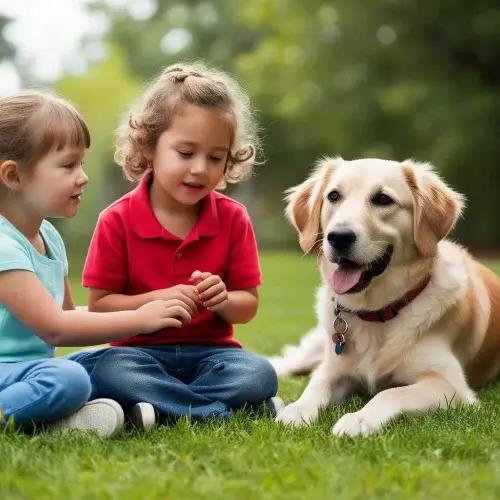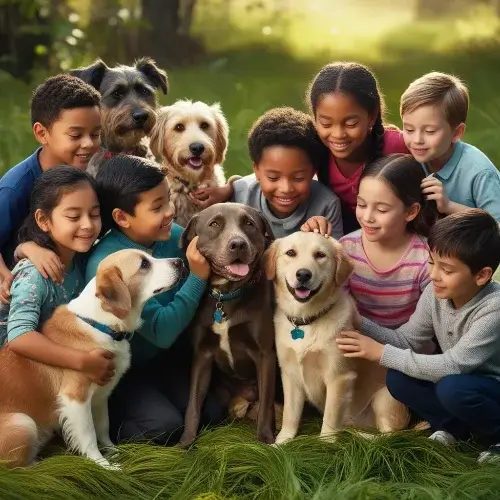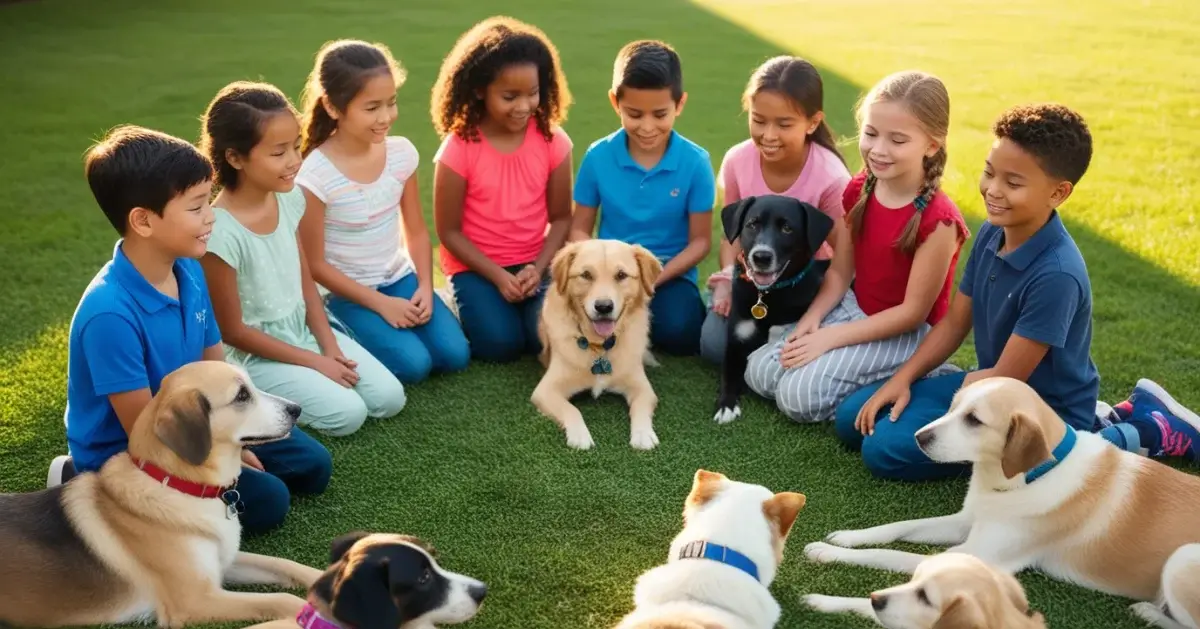Dogs and Children: Relationship and Benefits
The dogs and children relationship is special. A dog is more than a pet. It provides love, protection, and valuable life lessons.
Having a dog improves a child’s emotional, social, and cognitive development. It reduces stress, teaches responsibility, and encourages an active lifestyle. Dogs also help children with autism, ADHD, and anxiety feel secure and supported.
However, safety is essential. Not all dogs and children understand each other naturally. Training, supervision, and education ensure a safe and happy bond. This article explores the benefits of having a dog with kids, how they aid child development, and the importance of safety of dogs around children.
Table of Contents
The Benefits of Having a Dog with Kids
Emotional and Psychological Benefits
Dogs provide emotional support for children and create a sense of security.
- Their presence reduces stress, fear, and loneliness.
- Children feel understood and comforted during tough times.
- Therapy dogs help kids with autism and ADHD stay calm and focused.
For children struggling with emotions, a dog becomes a source of stability and reassurance.

Physical Health and Activity
Dogs keep kids active. They promote a healthier lifestyle through regular movement.
- Playing with a dog increases physical activity, improving heart health.
- Walking, running, and playing outside strengthen muscles and bones.
- Studies show that children who grow up with dogs develop stronger immune systems and have fewer allergies.
Having a dog encourages outdoor play and less screen time, benefiting overall health.
Teaching Responsibility and Empathy
Caring for a dog teaches responsibility from an early age.
- Feeding, grooming, and training create a sense of discipline.
- Understanding a dog’s needs builds empathy and respect for animals.
- Children learn patience and kindness through daily interactions.
These life lessons shape children into compassionate and responsible adults.
How Dogs Contribute to Child Development
Social and Behavioral Development
Dogs help children improve communication skills and confidence.
- Kids become more social by walking or playing with their dog.
- Dogs teach non-verbal communication and understanding emotions.
- Children with dogs often feel less lonely and more connected.
A well-socialized dog encourages positive social behavior and interaction.
Cognitive Development and Learning
Dogs make learning more engaging.
- Reading to a dog improves reading skills and confidence.
- Daily pet care teaches time management and responsibility.
- Training a dog helps develop problem-solving abilities.
The dogs and children relationship enhances both education and emotional growth.
Ensuring the Safety of Dogs Around Children
Teaching Kids How to Interact with Dogs Safely
Children must learn safe and respectful behavior around dogs.
- Avoid pulling ears, tails, or fur.
- Do not hug or put faces close to a dog’s face.
- Never disturb a dog while eating or sleeping.
Recognizing dog body language prevents misunderstandings. Signs of stress include yawning, lip-licking, and backing away.
Supervising Dog-Child Interactions
Supervision is necessary for all interactions between young children and dogs.
| Age Group | Supervision Level |
| 0-3 Years | Constant supervision |
| 4-7 Years | Frequent supervision |
| 8-12 Years | Occasional supervision |
| 13+ Years | Minimal, based on training |
Dogs need a safe space where they can rest without disturbance.
Training Dogs for Positive Child Interactions
A well-trained dog is a safer companion. Essential commands include:
- Sit, stay, and leave it – to control excitement and prevent rough play.
- Go to your place – helps dogs retreat when they feel overwhelmed.
- Socialization – exposure to children early builds trust and positive behavior.
Training and reward-based reinforcement ensure that both child and dog feel safe and comfortable.
Dogs as Emotional Support for Children
Therapy and Emotional Support Dogs
Some dogs play a bigger role in child emotional development.
- Therapy dogs assist children with autism, ADHD, and anxiety.
- Schools and hospitals use them to help children handle stress.
- Research shows that interacting with dogs reduces cortisol, a stress hormone.

These dogs provide calmness, comfort, and emotional stability in challenging situations.
Building a Lifelong Bond
The dogs and children relationship shapes childhood experiences and future connections with animals.
- Kids raised with dogs develop emotional intelligence and patience.
- They build a lifelong love and appreciation for animals.
- Positive early interactions lead to responsible pet ownership in adulthood.
A child who grows up with a dog carries those values for life.
Conclusion
The dogs and children relationship brings joy, companionship, and valuable lessons. Dogs provide emotional support for children, contribute to child development, and improve overall well-being.
They encourage an active lifestyle, social skills, and responsibility. However, ensuring the safety of dogs around children through training and supervision is essential.
Choosing to raise a child with a dog is a commitment that brings endless rewards. With proper care and guidance, this bond becomes a source of happiness and lifelong friendship.
Wouldn’t it be wonderful to see your child and dog grow up together, sharing love and adventure?
FAQs
What are the best dog breeds for families with young children?
Breeds like Labrador Retrievers, Golden Retrievers, and Beagles are known for their gentle nature. They are patient and highly trainable, making them ideal for dogs in child development by ensuring safe and positive interactions.
How can therapy dogs support children with special needs?
Dogs as emotional support for children with autism or ADHD provide comfort and stability. They reduce anxiety, improve focus, and help kids develop social confidence. Therapy dogs are trained to offer companionship and respond to emotional cues.
What are the safest ways for children to play with dogs?
Safe play includes fetch, hide-and-seek, and training games. Avoid rough play, tug-of-war, or disturbing a resting dog. Understanding the safety of dogs around children ensures fun interactions without stress or risk.
How can I teach my child to respect a dog's boundaries?
Set clear rules like avoiding tail pulling, hugging, or bothering a dog while eating. Teach kids to read body language and give dogs space when needed. Respecting these boundaries strengthens the dogs and children relationship and prevents misunderstandings.







